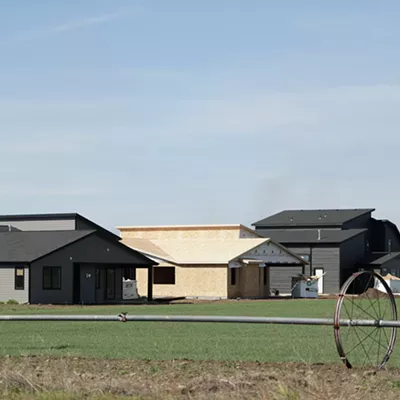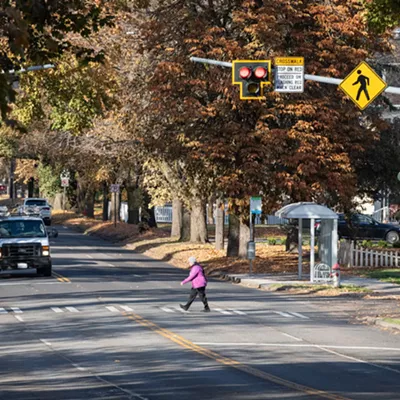Vertical Reach
[
{
"name": "Broadstreet - Instory",
"component": "25846487",
"insertPoint": "4",
"requiredCountToDisplay": "4"
},{
"name": "Broadstreet - Empower Local",
"component": "27852456",
"insertPoint": "8",
"requiredCountToDisplay": "8"
},{
"name": "Broadstreet - Instory",
"component": "25846487",
"insertPoint": "12",
"requiredCountToDisplay": "12"
},{
"name": "Broadstreet - Instory - 728x90 / 970x250",
"component": "27852677",
"insertPoint": "18",
"requiredCountToDisplay": "18"
},{
"name": "Broadstreet - Instory",
"component": "25846487",
"insertPoint": "5th",
"startingPoint": "23",
"requiredCountToDisplay": "24",
"maxInsertions": 100
}
]
Seattle's got 'em. Bellevue's got 'em. Even the Emirate of Dubai's got 'em. What do all these places have that Spokane doesn't? Tower cranes on the skyline. Take the 405 cutoff north from Interstate 90 just east of Seattle and soon, topping a little rise, downtown Bellevue jumps into sight and motorists can count as many as 12 tower cranes through their windshields.
"Downtown we have 14," says Bob Derrick, the economic development director for the City of Bellevue. "I read the other day there are 40 to 60 in the Puget Sound area."
The city of Dubai is said to have 1,200 tower cranes.
By stark contrast, there are none hovering above the downtown Spokane skyline.
Tower cranes are always said to be the Official Bird of Singapore, or Beijing, or Dubai, or Seattle -- or whatever city is going through a high-rise building boom at the moment. And the cranes are a sign, pundits are wont to say, of economic vitality.
The official Bird of Paradise.
So does the absence of the cranes say bad things about a city? A city such as, say, Spokane?
The answer depends on who you talk to.
"Definitely," says Greg Perry, a Windemere realtor in Bellevue who has posted a blog article titled "Erector Set City," about all the tower cranes leaning over the skyline. "I think the amount of cranes in a city are an indicator of the vibrancy of the city."
Not so much, counters Greg Hite, president of Hite Crane & amp; Rigging, a major provider of all manner of construction cranes around Spokane. "We don't have the land costs they do," Hite says of Seattle and Bellevue. "It's not as built-up already. I don't think [tower cranes] speak necessarily that the area is either healthy or unhealthy -- it's just different."
"I say good for Bellevue, but I don't want to drive in their traffic so much," says Rich Hadley, president and CEO of Greater Spokane, Incorporated, the regional chamber of commerce.
Tower cranes may very well be an economic indicator, Hadley says, but not the only one. "Look at the 2005-2007 time frame and our economic growth out-paced much of the rest of Washington. Some of what we are building may not require tower cranes." In 2006, employment growth in Spokane was 4.5 percent compared to the state's 2.5 percent and the nation's 1.4 percent, Hadley says.
Even though Spokane is the state's second-largest city, a variety of factors drive the disparity in tower cranes between here and Bellevue and Seattle.
One big difference is population density -- King County alone has roughly a third of the state's population at nearly 2 million of the state's 6.3 million people. The surrounding Pierce and Snohomish counties are nearly as dense.
Compare that to less than a half-million in Spokane County.
The greater population density drives development density, which has been encoded in both local and state planning laws.
"In the early 1980s," says Bellevue economic development director Derrick, "a coalition of city council members, property owners, developers all came up with a powerful vision of what downtown should be. And 20-some years later, it is happening.
"The vision incorporated high-rise office, high-rise retail and high-rise residential, and all that stuff is happening," Derrick says.
And it's been done while protecting traditional neighborhoods, he adds. "If you look at an oblique aerial view of Bellevue you will see neighborhoods coming right up to downtown and downtown going straight up. We committed to not having commercial development encroach on neighborhoods."
Derrick and the realtor Perry both add that Bellevue, like other densely populated cities around Puget Sound, have been strictly holding the line on the so-called urban growth boundaries that are an important part of the state's Growth Management Act.
The gist of the act is to drive growth into dense urban cores to prevent loss of open space and stop-and-go commuter-clogged freeways that come with sprawl.
It's another significant difference, Perry points out, that King County is squeezed between Puget Sound and the Cascade Range -- and there just isn't all that much room to sprawl.
Tim Welsh, president of Spokane's Garco Construction, went ahead and purchased a $1 million tower crane from Italy a couple of years ago and has been trying to keep it busy ever since in a county where there is less incentive to go vertical.
Garco needed a specific tower crane to build the egg-shaped digesters (really, that's what they are called) at the city's wastewater treatment plant. Renting one would have cost up to $30,000 a month, Welsh says.
Garco is currently using the crane to build a parking garage at Northern Quest Casino.
"We will be done there in November and are looking for other opportunities. It does us no good stacked on the ground," Welsh says.
Would he like to see a taller Spokane?
"I sure hope so," Welsh says. "I would love to build a 40-story tower in downtown Spokane." But he doesn't see Spokane getting more vertical any time soon.
"It's more expensive to build vertical than to build horizontal. So if you've got land available, you go sideways instead of up. In Spokane, we haven't had the kind of pressure that King County has, or Pierce or Snohomish," Welsh says.
Various boards of county commissioners could be seen as a factor in the lack of pressure to go vertical by fiddling with urban growth boundaries over the years.
Spokane County Commissioner Mark Richard is a fan of tower cranes, and he's astonished at the number of them he saw on the skylines of Calgary and Edmonton on a recent trade visit.
"It was mind-boggling," Richard says. "I always believe they are an [economic] indicator. Those are sizable commercial buildings being constructed when those cranes are employed. I wish we saw more of them here."
He agrees the county's large (and sometimes movable) urban growth boundary "could have some influence" on the lack of verticality. "The growth boundary adopted in 2001 -- have we filled that out? No, we haven't."
There are other factors at play, such as availability of land, lack of population pressure, public opposition to density as well as sprawl and the cost of vertical building, Richard says.
But the day may be coming when Spokane looks skyward.
The Downtown Plan is being updated and Marty Dickinson, president of Downtown Spokane Partnership, says a taller downtown is a goal. There are no height restrictions for downtown buildings, she says.
"I speak for downtown but I think all elected officials should do anything and everything to incent development in the urban core. For us to go the next level as an urban city, going vertical is something we need to do."
Bellevue realtor Perry says: "I think height comes with density. I'm no expert, but in Spokane I don't see that happening for a long time."
kevin@inlander.com
"Downtown we have 14," says Bob Derrick, the economic development director for the City of Bellevue. "I read the other day there are 40 to 60 in the Puget Sound area."
The city of Dubai is said to have 1,200 tower cranes.
By stark contrast, there are none hovering above the downtown Spokane skyline.
Tower cranes are always said to be the Official Bird of Singapore, or Beijing, or Dubai, or Seattle -- or whatever city is going through a high-rise building boom at the moment. And the cranes are a sign, pundits are wont to say, of economic vitality.
The official Bird of Paradise.
So does the absence of the cranes say bad things about a city? A city such as, say, Spokane?
The answer depends on who you talk to.
"Definitely," says Greg Perry, a Windemere realtor in Bellevue who has posted a blog article titled "Erector Set City," about all the tower cranes leaning over the skyline. "I think the amount of cranes in a city are an indicator of the vibrancy of the city."
Not so much, counters Greg Hite, president of Hite Crane & amp; Rigging, a major provider of all manner of construction cranes around Spokane. "We don't have the land costs they do," Hite says of Seattle and Bellevue. "It's not as built-up already. I don't think [tower cranes] speak necessarily that the area is either healthy or unhealthy -- it's just different."
"I say good for Bellevue, but I don't want to drive in their traffic so much," says Rich Hadley, president and CEO of Greater Spokane, Incorporated, the regional chamber of commerce.
Tower cranes may very well be an economic indicator, Hadley says, but not the only one. "Look at the 2005-2007 time frame and our economic growth out-paced much of the rest of Washington. Some of what we are building may not require tower cranes." In 2006, employment growth in Spokane was 4.5 percent compared to the state's 2.5 percent and the nation's 1.4 percent, Hadley says.
Even though Spokane is the state's second-largest city, a variety of factors drive the disparity in tower cranes between here and Bellevue and Seattle.
One big difference is population density -- King County alone has roughly a third of the state's population at nearly 2 million of the state's 6.3 million people. The surrounding Pierce and Snohomish counties are nearly as dense.
Compare that to less than a half-million in Spokane County.
The greater population density drives development density, which has been encoded in both local and state planning laws.
"In the early 1980s," says Bellevue economic development director Derrick, "a coalition of city council members, property owners, developers all came up with a powerful vision of what downtown should be. And 20-some years later, it is happening.
"The vision incorporated high-rise office, high-rise retail and high-rise residential, and all that stuff is happening," Derrick says.
And it's been done while protecting traditional neighborhoods, he adds. "If you look at an oblique aerial view of Bellevue you will see neighborhoods coming right up to downtown and downtown going straight up. We committed to not having commercial development encroach on neighborhoods."
Derrick and the realtor Perry both add that Bellevue, like other densely populated cities around Puget Sound, have been strictly holding the line on the so-called urban growth boundaries that are an important part of the state's Growth Management Act.
The gist of the act is to drive growth into dense urban cores to prevent loss of open space and stop-and-go commuter-clogged freeways that come with sprawl.
It's another significant difference, Perry points out, that King County is squeezed between Puget Sound and the Cascade Range -- and there just isn't all that much room to sprawl.
Tim Welsh, president of Spokane's Garco Construction, went ahead and purchased a $1 million tower crane from Italy a couple of years ago and has been trying to keep it busy ever since in a county where there is less incentive to go vertical.
Garco needed a specific tower crane to build the egg-shaped digesters (really, that's what they are called) at the city's wastewater treatment plant. Renting one would have cost up to $30,000 a month, Welsh says.
Garco is currently using the crane to build a parking garage at Northern Quest Casino.
"We will be done there in November and are looking for other opportunities. It does us no good stacked on the ground," Welsh says.
Would he like to see a taller Spokane?
"I sure hope so," Welsh says. "I would love to build a 40-story tower in downtown Spokane." But he doesn't see Spokane getting more vertical any time soon.
"It's more expensive to build vertical than to build horizontal. So if you've got land available, you go sideways instead of up. In Spokane, we haven't had the kind of pressure that King County has, or Pierce or Snohomish," Welsh says.
Various boards of county commissioners could be seen as a factor in the lack of pressure to go vertical by fiddling with urban growth boundaries over the years.
Spokane County Commissioner Mark Richard is a fan of tower cranes, and he's astonished at the number of them he saw on the skylines of Calgary and Edmonton on a recent trade visit.
"It was mind-boggling," Richard says. "I always believe they are an [economic] indicator. Those are sizable commercial buildings being constructed when those cranes are employed. I wish we saw more of them here."
He agrees the county's large (and sometimes movable) urban growth boundary "could have some influence" on the lack of verticality. "The growth boundary adopted in 2001 -- have we filled that out? No, we haven't."
There are other factors at play, such as availability of land, lack of population pressure, public opposition to density as well as sprawl and the cost of vertical building, Richard says.
But the day may be coming when Spokane looks skyward.
The Downtown Plan is being updated and Marty Dickinson, president of Downtown Spokane Partnership, says a taller downtown is a goal. There are no height restrictions for downtown buildings, she says.
"I speak for downtown but I think all elected officials should do anything and everything to incent development in the urban core. For us to go the next level as an urban city, going vertical is something we need to do."
Bellevue realtor Perry says: "I think height comes with density. I'm no expert, but in Spokane I don't see that happening for a long time."
kevin@inlander.com
















